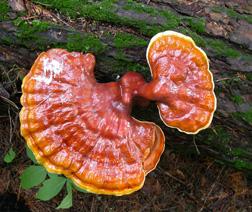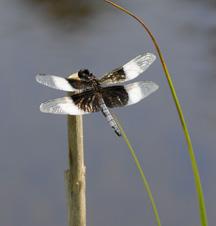Wet Year a Boon to Many Species
- Share
- Tweet
- Pin
- Share

A Baltimore Checkerspot butterfly on a Swamp Milkweed flower. Photo by Roy Lukes.
In 38 years of gardening, never have we had to do so little watering, as plentiful rain came at just the right times in 2010. It was a factor that had a positive effect on much of the great outdoors in Door County.
Coupled with favorable overall weather conditions, the rain helped many plants and animals rebound in numbers following several very droughty summers. For example, the largest crops of soybeans and corn in history were harvested in Wisconsin. Fortunately very favorable pricing accompanied this banner crop year. Prime conditions for planting, growing and harvesting occurred.
This turned out to be true as well for dragonflies. My friend Joe Wallner and I found several of their usual breeding and hunting sloughs and ponds in excellent water level. This brought very good photography of several species including the Common Green Darner, White-tailed Skimmer, Widow Skimmer, Twelve-spotted Skimmer, White-faced Meadowhawk and Crimson-ringed Whiteface.
Dr. Paul Burton, Door County’s dragonfly expert, said dragonflies in general held their own well this past year. It was an average summer, neither the best nor the worst. Fortunately the habitat and population of the federally endangered Hines Emerald Dragonfly, more abundant in Door County than anywhere in the world, appeared to hold an even course.
Though the extra rain would appear to support high butterfly populations, such is not always the case. Their populations usually tend to fluctuate from year to year depending on the success of the previous breeding season, severity of the winters and the presence of disease parasites and other harmful organisms.

A fresh Hemlock Polypore at Toft Point State Natural Area in Baileys Harbor. Photo by Roy Lukes.
Several butterfly species, including the Red Admiral, White Admiral, both the Black and the Tiger Swallowtails, Mourning Cloak, and the Monarch butterflies were not especially common this past summer. It wasn’t until their second brood that we began seeing good numbers of the Monarchs. What surprised us, in spite of our Monarch food patch containing Red Milkweeds and Mexican Milkweeds (some of their favorite host plants) being literally eaten to shreds, was that we could find very few of the Monarch chrysalides. Yet, come fall, we felt that the number of adults observed during their migration southward was quite good.
One butterfly species, the elusive yet usually tame and confiding Baltimore Checkerspot, appeared to be doing well wherever it’s very limited populations of Turtlehead wildflowers grew. This plant does best wherever it can keep its “feet” wet, further highlighting the importance of adequate rainfall to maintain the wetlands.
For the past few years we’ve bought our annual supply of Honey Gold and Cortland Apples, along with Stanley Prune Plums for canning, from the orchards of Dan and Sheri Krowas west of Kangaroo Lake. Weather conditions seemed to cooperate nicely for a change. Killing frosts, proper conditions for good pollination, wind and hail storms all have to be taken into account. They reported a very good crop of Cortlands but the weather continued too warm into fall for the proper ripening, coloring up and sweetening of the Honey Gold, my favorite. This apple requires colder fall weather. By the way, it was the crossbreeding of the Honey Gold and the McCown Apples which produced the popular Honey Crisp.
Several consecutive dry summers prior to this year proved to be very hard on the trees of our county, especially the conifers which winter poorly when summer and fall rainfall is sparse. Combine this condition with the generally shallow soil here and a year of high winds in the county, and this results in weakened trees and many tip-overs. We lost a much higher-than-usual number of Quaking Aspens, which we prize highly because of the positive relationship with Ruffed Grouse. The winter buds of especially the older male aspens constitute the grouses’ major winter food source.

A Widow Skimmer Dragonfly. Photo by Roy Lukes.
Tip-overs are not necessarily bad because the newly created openings favor the growth of many smaller plant species. A case in point is the federally-threatened Lake Iris, whose population requires periodical blow-downs of trees in order to expand their rather demanding growing conditions.
What a banner year this proved to be for the growth of wild mushrooms. Finally the rains came when they were most needed, unlike the several previous dry autumn seasons. Once Charlotte’s list of Door County mushrooms reached 540 species, accumulated over 38 years, new finds came very slowly. The welcome rains changed the picture remarkably. Even a mid-November hike with our friends Don and Beth Bartoli, on a very cold afternoon at Peninsula State Park, produced the Red Tree Brain, number 550. Surely this excellent year for the mushrooms is what triggered Charlotte’s decision to finally begin writing her long-overdue “Mushrooms of Door County” book this winter.
I look at most of my photography as “ecological photography” in my attempt to record and document daily changes in the natural history of Door County from year to year. Coupled with recording the daily phenological occurrences and sightings, this helps provide Charlotte and me with pretty sound overall pictures of the trees, mushrooms, animals, birds, wildflowers, ferns, mosses, lichens, butterflies, dragonflies, etc.
What has become very apparent to us over the years is the obvious growing and glaring trends of disconnection of people of all ages with the natural world. In spite of our deep concern, I must admit that it’s been very exciting working to keep abreast of nature and its changes from year to year. What will be extremely rewarding will be when the citizens of all ages work together to bring about and maintain a healthier natural world.


